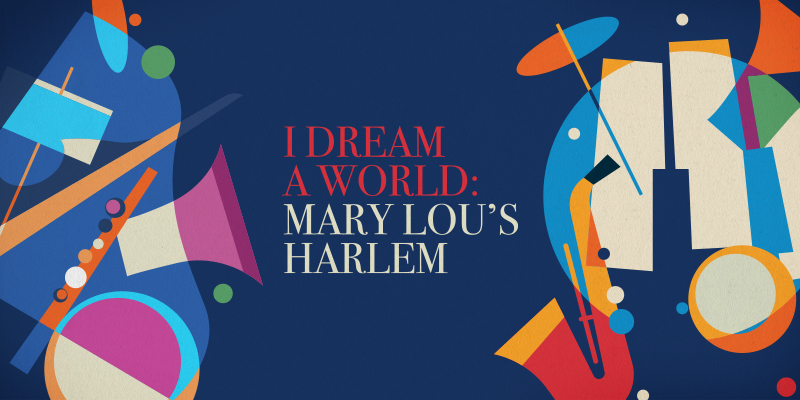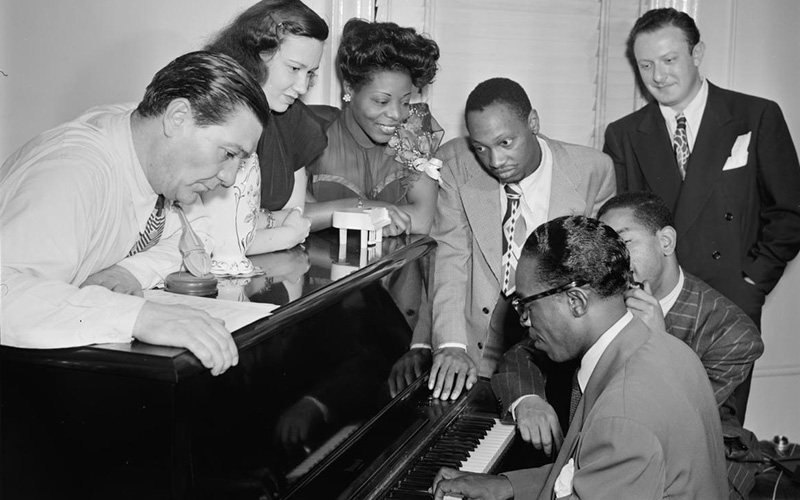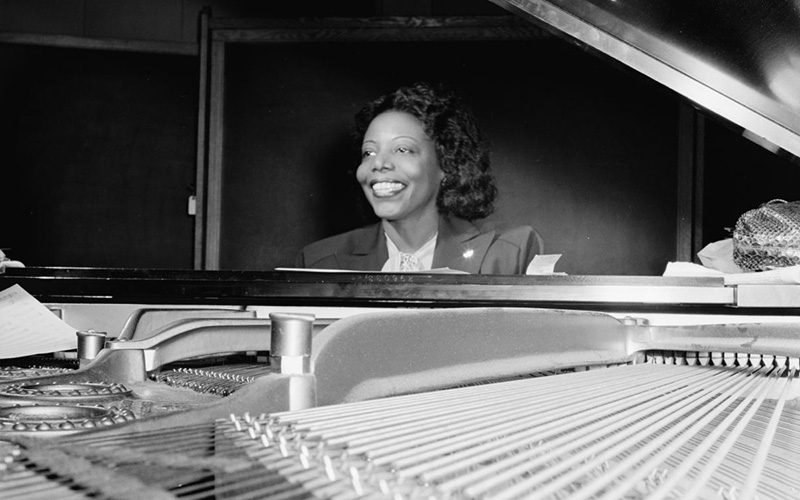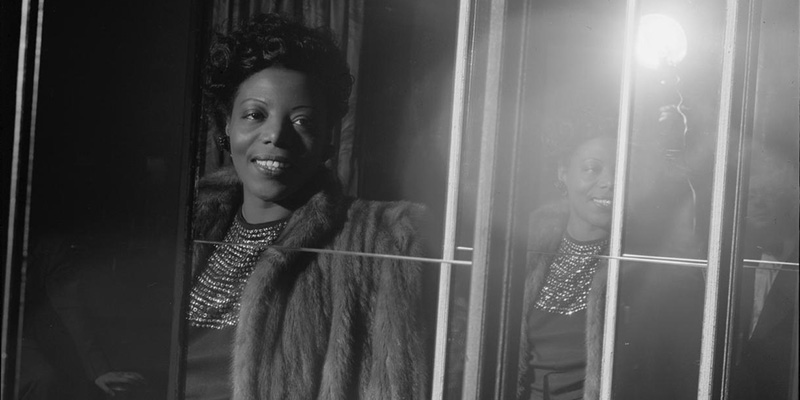News
November 30, 2023
Meet Mary Lou Williams: The First Lady of Jazz
Now in its third consecutive year, New World Symphony's “I Dream a World” festival returns this February with a series of programs that honor the life and work of the “first lady of jazz,” legendary pianist and composer Mary Lou Williams. Curated in collaboration with Dr. Tammy Kernodle, Miami University of Ohio Distinguished Professor in the Department of Music, the multi-disciplinary festival titled “Mary Lou’s Harlem” features a roster of acclaimed artists uniting to celebrate the lasting legacy of one of the most influential, yet least known jazz artists of all time.
“Mary Lou Williams was an arranger, composer, pianist, educator, and activist that exemplified all the complexities, tragedy, and joy that is embodied in jazz and American music,” said Dr. Kernodle. “Her name might not be as well-known as Ellington, Miles, Coltrane, or Louis Armstrong, but Mary Lou was just as influential as each of them in shaping the identity of jazz music and elevating it beyond conventional discussions about popular music and classical music. I often characterize her work as ‘genius without borders.’ The ‘I Dream a World’ festival will not only illuminate the vastness of Mary Lou Williams' contributions to American music and jazz, but also the social and cultural circles with which she engaged.”
Get to know Mary Lou Williams—a jazz woman in a jazzman's world—through excerpts from Dr. Kernodle’s biography Soul on Soul: The Life and Music of Mary Lou Williams:

Mary Lou Williams, CBS studio, New York, N.Y., ca. Apr. 1947, photo by William P. Gottlieb, Library of Congress
Defining Mary Lou Williams is an arduous and consuming task. After all, she is the only jazz performer to date to have played in every stylistic period of jazz spanning the years from 1920s to the 1970s. At the time of her death in 1981, Mary Lou Williams had written more than 100 compositions or arrangements, recorded over 100 records, and performed on stages from California to New York, Florida to Canada, London to Copenhagen, and many points in between.
More than 40 years after her death, scholars, historians, family and fans are still trying to understand the complexities that drove Mary Lou Williams to become one of the most celebrated women in jazz. At a time when most jazz performers perfected a particular style and maintained it, Mary experimented with emerging styles. She not only perfected the techniques utilized by most arrangers in the 1930s and 1940s, she also experimented with unusual instrumental combinations and rhythmic patterns that reshaped the manner in which band leaders, musicians, and listeners interpreted “swing.”
Mary Lou Williams was one of only a few jazz musicians to have played in all the eras of jazz. She operated within the collegial but male-dominated boundaries of jazz ensembles, and, although the experiences were less than perfect, they had earned her a level of fame that was comparable to that of many of her well-known counterparts. No woman other than vocalists Billie Holiday and Ella Fitzgerald had so dominated the swing scene or earned the genuine respect of band leaders and musicians alike. Mary would become one of the few female jazz instrumentalists to escape the “ghetto” of all female orchestras and novelty groups in the 1930s and 1940s, and her presence on the bandstand countered widely held assumptions about women's ability to participate in jazz as instrumentalists.
Mary had seemingly broken through the “glass ceiling” that had prevented many talented jazz women from pursuing their professional goals. She had no intention of being an activist or spokesperson for what could safely be termed feminist causes. Instead she wanted to write music, expand her knowledge of the art form by studying the compositions of European composers, and find happiness in her personal life.
Mary Lou Williams’ 60-year career was enhanced by her constant need to innovate and experiment. She integrated Black vernacular forms unashamedly into mainstream forms, thus introducing white and black listeners to musical genres that they had never before heard or that they found difficult to decipher.
Portrait of Jack Teagarden, Dixie Bailey, Mary Lou Williams, Tadd Dameron, Hank Jones, Dizzy Gillespie, and Milt Orent, Mary Lou Williams' apartment, New York, N.Y., ca. Aug. 1947, photo by William P. Gottlieb, Library of Congress
Mary Lou’s Harlem
Mary Lou Williams spent various periods throughout her career in Harlem because of her work on the vaudeville circuit. She first was there in the late 1920s—in the middle of the Harlem Renaissance movement—and later returned and settled there in 1943, where her apartment was a gathering space for musicians exploring modern jazz and bebop.
To 17-year-old Mary, Harlem was both exciting and frightening. In 1927 it was a bustling haven for migrant Blacks from the eastern seaboard seeking new lives, and the cradle of the new Black cultural renaissance. Since 1900 Blacks had been migrating to the borough, abandoning the West Side, where they had previously been concentrated. This migration to Harlem was due in part to the overcrowded conditions and increased eruptions of anti-Black feelings. Up until 1900 Harlem had been largely a white neighborhood, but by 1930 most of this population was replaced by Blacks who inhabited every part of the district.
The Harlem Mary came to in the late 1920s had a split personality. The Harlem Renaissance had peaked as Black intellectuals, writers, painters, and composers attempted to provide America with a different representation of Black life. This Renaissance, also known as the New Negro Movement, separated Black highbrow and lowbrow cultures. Average Harlemites struggled daily to make ends meet and released their stress through the music and dance of the rent parties, churches, nightclubs, and ballrooms scattered around the borough. Mary's experiences in New York would place her at the heart of the developing New York Jazz scene.
As Mary continued to navigate through the New York scene, a new underground jazz movement grabbed her attention. This movement was headed by a group of young musicians–Thelonious Monk, Dizzy Gillespie, Charlie Parker, Max Roach–who believed that swing had diluted jazz and had pushed Black musicians and bandleaders into obscurity. This newly conceived sound, called bebop because of the rapid-fire phrases musicians played, would become these musicians’ response to swing and to the commercialization of jazz.
Mary's apartment at 63 Hamilton Terrace in Harlem became the setting for a modern-day “salon” that paralleled 19th-century French musical circles. Each night she hosted musicians as they sat around discussing music, listening to recordings, and writing new tunes. “It was like the 30s,” she said. “Musicians helped each other and didn't just think of themselves. [Thelonious] Monk, Tadd Dameron, Kenny Dorham, Bud Powell, Aaron Bridgers, Billy Strayhorn, plus various disc jockeys and newspapermen, would be in and out of my place at all hours and we'd really ball.” Mary became the matriarch of the modern jazz movement when she opened her apartment and ears to the musical and personal concerns of bebop musicians.
Mary Lou Williams, CBS studio, New York, N.Y., ca. Apr. 1947, photo by William P. Gottlieb, Library of Congress
Mary Lou’s Zodiac Suite
It was during her nightly performances at New York’s Café Society Uptown–the City’s first integrated nightclub–that Mary began working on a new set of compositions based on the signs of the zodiac. She had conceived the idea of writing and debuting a movement each week at Café Society, but she wrote only three movements while at the nightclub. Still, she intended to complete the cycle. Although Mary had no deep interest in astrology, she thought that the characteristics presumed to attach to these signs would be a way of sketching musical portraits of specific persons born under those signs. When asked about the genesis of these works, she said “I read a book about astrology and though I didn't know too much about it, I decided to do this suite based on musicians I knew born under the various signs.”
Each sign was conceived musically as a separate and individual idea. Aries was written for Ben Webster and Billie Holiday, who had both supported Mary musically during the most experimental periods of her life. Mary created two different versions of the movement, which she said represented musical freedom because both Webster and Holiday had, through their musical approaches, expanded the boundaries of jazz. Taurus–recorded previously under the title Taurus Mood in 1944–was dedicated to Duke Ellington, Ellis Larkins, and herself. Gemini was written for Benny Goodman, Mary's former husband Harold Baker, and Miles Davis. Dizzy Gillespie, Mary's closest friend, was honored with Libra along with Art Tatum, Thelonious Monk and Bud Powell. Aquarius was dedicated to President Franklin D Roosevelt. Pisces was written in the form of a jazz waltz and dedicated to Barney Josephson, founder of Café Society.
The Zodiac Suite reflected Mary's expanding perspectives on jazz. Her subsequent versions would place the composition in the category of Duke Ellington's extended works, which also combine elements of the classical tradition with jazz. Mary viewed the completion of the work as the beginning of a new phase of her development as a composer and a musician. “I have worked all my life to write and develop serious music that is both original and creative.” she said. “The Zodiac Suite is the beginning of a real fulfillment of one of my ambitions.”
Portrait of Mary Lou Williams, between 1938 and 1948, photo by William P. Gottlieb, Library of Congress
Mary Lou’s Mass
The last years of Mary’s life saw the flowering of her faith and her desire to use her music in ways that would raise social consciousness and bring emotional healing to her listeners. Mary was a woman searching for inner peace, a peace that would surpass all understanding. She had experienced so many of the material pleasures the world had to offer but still had not found emotional comfort. Mary's turn to spirituality was emblematic of the shift towards religion that began to sweep through the jazz community in the 1940s and 50s.
For years, the priests who had been Mary's friends had begged her to compose a jazz mass. Mary had never seriously considered it until she started working at Seton. It not only broadened her perspective on the possibilities of religious jazz music but also became a great vehicle for teaching her students. Mary's first attempt at writing an extended composition setting the Ordinary of the mass is simply called Mass. The multi-movement work indicates Mary's evolving compositional style and a sensitive liturgical approach. The work as a whole displays Mary's affinity for the blues and other jazz styles. Although Mary would later contend that her Mass “wasn't really jazz,” she established a blues and jazz sound through her choice of instrumentation and harmonies. She would later claim to have used the distinction to save jazz. Mary was continuing the work of Joseph Rivers–best known for his efforts to revitalize American Catholic music–in establishing a Black liturgical identity within the church. Before the decade was over, Mary had broken down many of the barriers to the idea of spiritual jazz.

Portrait of Mary Lou Williams, Café Society (Downtown), New York, N.Y., ca. June 1947, photo by William P. Gottlieb, Library of Congress
Mary Lou’s Tree of Jazz
Mary believed that a true understanding of the Black race and its culture lay in the exploration of its roots. The history of the music and experiences, not the radical intellectual hyperbole of the musicians, activists, and writers who are constructing their own sense of cultural reality. Mary became more determined than ever to bring clarity to the historical and cultural merits of jazz.
Mary's Tree of Jazz illustration has three major parts: the trunk, which represents the inspirations of jazz (such as the suffering of slaves and the blues) and the evolution of the genre, from spirituals to ragtime to Kansas City Swing to bebop; the leaves of the tree, which contain the names of musicians and composers who have contributed to the genre; and the barren limbs which bear the names “commercial rock,” “black magic,” “cults’” “avant-garde,” “exercises,” and “classical books.” Perhaps the most tangible representation in Mary's rhetorical perspective on jazz in the 1970s, the “Tree of Jazz” closely matched her mantra, which appeared in almost every interview dating from this period: “Jazz is Black Heritage and a true American art form which is spiritual and healing to the soul.”
She would often begin her discussions of jazz with the assertion, “Jazz and the spirituals are the only American-born art. From suffering came the spirituals. Songs of joy and songs of sorrow. The main origin of American jazz is a spiritual. Because of the deeply religious background of the Black American he was able to mix the strong influence with rhythms that reach deep enough into the inner self to give expression to outcries of sincere joy, which became known as jazz.” Mary generally explained in her lectures that she and many other musicians objected to the use of a single word to describe the diverse approaches within the tradition. Although musicians and scholars have attempted to use numerous terms to describe the music, she explained “the title Jazz has survived it all.”
2024 “I DREAM A WORLD” FESTIVAL EVENTS
Please visit nws.edu/harlem for more information and to purchase tickets.
Concert for Kids: I Dream a World | Sunday, February 4, 2024
New World Center, Michael Tilson Thomas Performance Hall, 11:30 a.m.
Molly Turner, NWS Conducting Fellow
NWS Conducting Fellow Molly Turner leads a special program for young audiences that focuses on the life story of Mary Lou Williams featuring music by Mary Lou Williams, Duke Ellington and more.
Film Screening: “Mary Lou Williams: The Lady Who Swings the Band” (2015) | Wednesday, February 7, 2024
SoundScape Park, 8:00 p.m
In collaboration with the American Black Film Festival, NWS presents this feature documentary on the life and music of Mary Lou Williams, voiced by Alfre Woodard and featuring “I Dream a World” guest artist Carmen Lundy and festival curator Dr. Tammy Kernodle.
Chamber Music: In the Land of Oo Blah Dee | Thursday, February 8, 2024
The Black Archives Historic Lyric Theater at 7:30 p.m.
NWS Fellows and guests return to The Black Archives Historic Lyric Theater in Overtown to present chamber music by Mary Lou Williams, Thelonius Monk, Valerie Coleman, David Baker and more.
Cabaret: Mary Lou’s Salon | Thursday, February 22, 2024
New World Center, Truist Pavilion at 7:30 p.m.
Pianist Aaron Diehl and his jazz trio join NWS Fellows for a presentation of piano-centric music by Mary Lou Williams and those within her musical inner circle.
The Soundworld of Mary Lou Williams
February 24, 2024 at 7:30 p.m.
February 25, 2024 at 2:00 p.m.
New World Center, Michael Tilson Thomas Performance Hall
Andrew Grams, conductor
Carmen Lundy, soprano
Aaron Diehl Trio
Ambassador Chorale of Florida Memorial University
Jazz Vocal Ensemble of Florida International University
The festival culminates in an orchestral program led by Andrew Grams that includes the world premiere of a newly uncovered work by Mary Lou Williams, History: A Wind Symphony, that was discovered by Duke University. Also on the program are selections from Mary Lou Williams’ Zodiac Suite, Mass and songs.
Art and Artifact Exhibits | Starting February 22, 2024
New World Center, Atrium and Clinton Ensemble Room
In partnership with the Institute of Jazz Studies, New World Symphony will display a collection of Mary Lou Williams artifacts in the Atrium of the New World Center. Christopher Norwood, curator and founder of Hampton Art Lovers at the Historic Ward Rooming House, returns for a special art exhibition inspired by Mary Lou Williams. Both exhibits will be available to ticket holders of the February 22, 24, and 25 performances.
36 Keys | Online Resource Library
As part of the first festival, New World Symphony launched 36 Keys. Named for the number of black keys on a piano, the website is a resource library dedicated to the keyboard-centric music of Black composers. Designed for students, teachers, performers, programmers and music lovers of all backgrounds, 36 Keys offers biographical information about composers and reference materials by musicologist Elizabeth Durrant, and exceptional video recordings with statements by the artists.
Posted in: Concerts, Events, I Dream a World, Mobile Wallcast Concerts, Wallcast Concerts











